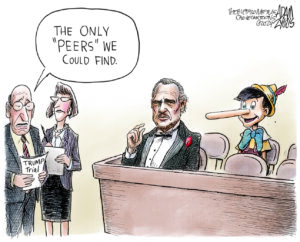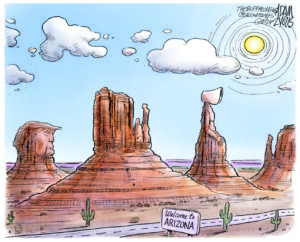The U.S. Alone Is to Blame for a War With Iran
As the two nations move inexorably closer to a full-scale conflict, it's essential that we recognize who started this cycle of violence. Secretary of State Mike Pompeo. (Ministry of Foreign Affairs of the Republic of Poland / Flickr)
Secretary of State Mike Pompeo. (Ministry of Foreign Affairs of the Republic of Poland / Flickr)
This article originally appeared on antiwar.com.
We, as Americans, are now living in different realities. The almost completely partisan response to Donald Trump’s decision to assassinate one of Iran’s top leaders proves that once and for all. To listen to Mitch McConnell versus Nancy Pelosi – and just about all their underlings – argue about the execution, is to almost believe each are talking about a different event! It’s surreal. Trump hit Iran, he says, because Iran hit us. Trump calls Soleimani a “terrorist” mastermind; Iran calls the assassination an “act of terrorism.” Are both right? Who knows…but…who started this whole mess?!?
Truth is, few politicians or commentators on the mainstream left or right bother to ask who started the now open-shooting-conflict between Iran and America. Don’t get me wrong, both sides starkly disagree on whether Trump’s assassination of Major General Qasem Soleimani was strategic, (it wasn’t) or whether the president ought to have sought congressional approval (he should have). Still, both Democrats and Republicans almost unanimously believe that – whether war is the answer or not – Iran is ultimately in the wrong, the villain of the whole sordid tale.
I, on the other hand, sympathies aside, have the luxury of (mostly) intellectual independence. And I’m an historian. Therefore let me address the title question in a rather uncomfortable manner. The answer, I surmise, is complex, but, to trained scholar or regional analyst, unsurprising: the United States of America. This is not to say Iran hasn’t played a nefarious part of its own, or that there was zero blood on Soleimani’s hands, or that there aren’t human rights violations within the Islamic State. My narrow – but profoundly consequential – assertion is simply this: between the two adversaries, it was the United States that “started” the insults and provocations that got-us-hear, so to speak.
So, where is here, exactly? A state of war, of course. The targeted killing of a sovereign nation’s top uniformed military officer is quite obviously tantamount to war. Imagine how the U.S. would have responded if, on December 6th, 1941, the Germans assassinated Army Chief of Staff George Marshall. With a declaration of war, certainly, perhaps against Germany and its ally, Japan – potentially doing so a day before the real-world Pearl Harbor attack of December 7th. Or, in a more modern counterfactual scenario, would America eschew retaliation, at a minimum, or, more likely, open warfare, were Iran to have blown away Generals Petraeus or Mattis, back when they were still in Iraq? Don’t be silly. It’s valuable, remember, to walk a mile in an opponent’s shoes – in this case, to consider the view from Tehran.
Let us agree, then, that – for better or worse – Mr. Trump has started a war. What’s perhaps more troubling is that he has unilaterally done so, committed America to – what Trita Parsi of the Quincy Institute recently called – an “irreversible escalation.” In doing so, he’s left Congress, the US military, and the People, to pick up the pieces. The president’s purpose, or at least his outcome, has been to engender a de-facto state of war, to commit the US to a combat fait accompli.
He’s not the first president to do it. Back in 1846, President James K. Polk – another dark horse candidate – by supporting the annexation of the breakaway Mexican province of Texas, and then ordering an army across the internationally recognized border, unilaterally made the resultant war – the deadliest per capita for US troops in history – all but inevitable. That, we now know, was his purpose. Problem is, whether a Polk or a Trump or some future blowhard is in the White House, that’s decidedly not how the Constitution says its supposed to work!
Nevertheless, it seems it is too late now. What’s done is – absent an unlikely wave of antiwar people’s protests – as they say, done. Trump has changed the paradigm. See, undeclared, proxy (until now) war had long been the name of the game played by the US and Iran. As such, it was waged as a retaliatory cycle, with each side pointing blame-riddled fingers at the other. So, times being as dark as they are, let me indulge the blame-seekers, and do my best to trace the timeline of provocations and retaliations. Only, to keep it interesting – and because I think it more instructive – I’ll do so in reverse.
- Since I don’t know when it will happen (perhaps before publication of this piece?), but am certain that it will, I’ll start with what will be Iran’s promised and likely bloody response attack on US personnel somewhere in the world. Americans will, across the spectrum, be shocked – just shocked!
- But, Iran only responded to the American assassination of perhaps the second or third most powerful man in Tehran’s government.
- Well, an Iranian-backed militias had “attacked” the US embassy in Baghdad – though this was, for the Americans, a bloodless event.
- But, the US had killed some two dozen members of the militia in a series of airstrikes.
- Well, this was in response to the group’s alleged responsibility for a rocket attack on a US base in Iraq that killed an American contractor.
- But, Trump had been funneling extra US troops into Saudi Arabia – Iran’s sworn enemy – and de facto sanctioned numerous, illegal, Israeli airstrikes on Iranian personnel and Iraqi militias in both Syria and Iraq.
- Well, in September, Yemeni Houthi rebels – loosely affiliated with Iran – claimed responsibility for a temporarily crippling attack on Saudi oil infrastructure.
- But, the U.S.-backed Saudi coalition had been terror bombing Yemeni civilians for four years, causing the world’s worst man-made humanitarian disaster.
- Well, in June, Iran shot down an American drone that was allegedly over international airspace.
- But the Trump administration’s had labeled the Iranian Revolutionary Guards Corps (IRGC) – which Soleimani commanded – a foreign terrorist organization, for the first time in history. (Iran designated US Central Command – which has responsibility for the entire Middle East – a terrorist organization, in response, days later.)
- Well, in May, Trump claimed that Iran was behind attacks on a few Saudi oil tankers.
- But, a year earlier, Trump had unilaterally pulled out of a multinational Obama-era nuclear deal, in spite of clear evidence that Iran had followed its strictures. Furthermore, rhetoric in Washington – particularly from John Bolton – had grown increasingly pugnacious and later Bolton reportedly ordered the Pentagon to update plans to send 120,000 additional troops into the Persian Gulf.
- Well, Iranian troops and friendly militias had long been “meddling” in Syria to back President Assad (though they were, unlike the US, invited, and partly combated the mutual enemy of ISIS)
- But, Iran could (cogently) argue that the US had indirectly backed Al Qaeda elements in Syria and, through its ill-fated invasion of Iraq, set the conditions that created ISIS in the first place.
- Well, according to the official Washington line, at least, Iran had backed the militias and provided the technology to kill hundreds of US troops in Iraq. (Though there is much evidence to the contrary, and much talk about the Iranian bogeyman in Iraq may be mythology.)
- But, even so, the US had invaded both of Iran’s main neighbors – Afghanistan (2001) and Iraq (2003) – surrounding the country with American military bases. Furthermore, Iran felt genuinely threatened, which was understandable given that Bush administration officials were itching for regime change in Iran. “Everyone wants to go to Baghdad. Real men want to go to Tehran,” was a common trope around neocon circles in Washington. Heck, Bush had even included Iran in the “axis of evil” triumvirate in his speech.
Now, I could stop here, in 2003, and declare America the primary aggressor. That would be fair. But I won’t. Instead, let us take an ever so brief trip further down memory land.
- Bush would argue his invasions and rhetoric were justified, since some Iranians had long chanted that the US was “the Great Satan,” and publicly burned the American flag. And, according to a US judge, at least, Iran had been responsible for the Khobar Towers bombing in 1996 that had killed American servicemen. (There is still much debate on who was actually responsible)
- But, during the eight-year Iran-Iraq War, which caused perhaps a million deaths, the US Navy waged an undeclared maritime war in the Persian Gulf. In the “Tanker War,” the US flew the stars and stripes on Kuwaiti vessels to protect them from attack, and, finally, in April 1988, overtly sank the majority of the Iranian Navy in a one-sided sea battle.
- Well, during that existential war, Iran had attacked Iraqi and its allies’ tankers; furthermore, its Lebanese partner Hezbollah had taken several Americans hostage.
- But, throughout the war (1980-88), which Iraq had started by invading Iran, the US openly backed the Saddam Hussein’s aggressive regime. The US provided key intelligence in the form of satellite photos to the Iraqi Army, and granted Baghdad over $1 billion in economic aid. President Reagan, in absurd twist of irony, sent a special envoy, Donald Rumsfeld, to meet with Saddam. Saddam regularly employed poison gas to attack Iranian formations. It is largely agreed that U.S.-supplied satellite imagery allowed Iraq to better calibrate these illegal, immoral, chemical attacks.
- Well, in 1979, during Iran’s Islamic Revolution, dozens of American embassy personnel were taken hostage and held for more than a year.
- But here’s the kicker: Back in 1941, though Tehran declared neutrality in the world war, Russia and Britain jointly invaded and occupied the country to secure control of its oil reserves. Then, in 1953, when a democratically elected prime minister – Mohammad Mossadegh – dared nationalize Iranian oil (which had been largely under Western corporate control) the CIA coordinated a coup with MI6 to overthrow the government. The dictatorial Shah was promptly put in power and ruled with an iron fist for the next 26 years. America had armed, funded, and backed this brutal regime for two and a half decades.
And that, folks, an aggressive, illegal, intervention to overthrow an elected government – one of the most intrusive sins in foreign affairs – amounts to checkmate in the blame-game: Uncle Sam started it! You know something else? That still matters.
Your support matters…Independent journalism is under threat and overshadowed by heavily funded mainstream media.
You can help level the playing field. Become a member.
Your tax-deductible contribution keeps us digging beneath the headlines to give you thought-provoking, investigative reporting and analysis that unearths what's really happening- without compromise.
Give today to support our courageous, independent journalists.






You need to be a supporter to comment.
There are currently no responses to this article.
Be the first to respond.